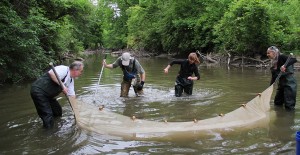
 Faculty sample and measure fish along a 300-foot stretch of the Rouge River. Photo by Jacob Napieralski.
Faculty sample and measure fish along a 300-foot stretch of the Rouge River. Photo by Jacob Napieralski.
The Great Lakes span nearly 100,000 square miles.
That leaves plenty of room for Michigan residents to reel in fish, cast their sails and splash around.
But the Great Lakes also are host to their share of problems. Two University of Michigan-Dearborn scientists hope to solve some of those problems, thanks to Great Lakes restoration grants recently awarded by the new University of Michigan Water Center.
“We’re really excited that the Water Center saw the opportunity for both of us to provide unique solutions to this really great challenge that’s going on with the Great Lakes,” said Justin Saarinen, UM-Dearborn assistant research scientist. “We’ve definitely trained ourselves and are well equipped, and we have the enthusiasm and the excitement to do this type of work.”
Saarinen and his wife, Emily, an assistant professor of biological sciences at UM-Dearborn, will lead separate projects that aim to support and enhance restoration and protection efforts within the Great Lakes basin. Their projects were among only 12 research ideas submitted by scientists nationwide that were awarded funding.
“These initial grants are to an exceptional few projects that really addressed our goals and clearly identified outcomes that matter to the region’s resource management community,” said Water Center Director Allen Burton. “They are going to fill key gaps in our restoration knowledge.”
Justin Saarinen plans to fill a key gap by conducting a water quality benefit assessment of Lake Erie’s coastal wetlands. He plans to identify alternative restoration scenarios for western Lake Erie by assessing whether restoring coastal wetlands provides a significant water-quality benefit to the lake.
“These challenges are great,” he said. “Some would refer to them as wicked challenges. They’re not something that a silver bullet can handle. This is an accumulation of stressors that are causing problems.”
Meanwhile, Emily Saarinen will focus her efforts on monitoring how the fish community has responded to restoration activities in the Rouge River watershed. The river has undergone restoration efforts aimed at improving water quality, including the removal of a dam near Wayne Road, so her goal will be to determine how the fish community has been directly impacted.
“We feel a great responsibility,” she said. “We both care a lot about the Great Lakes. It’s the largest store of fresh water on Earth and we need to make sure that we’re managing it effectively.”
Funding for both projects kicks in July 1, but the Saarinen’s already have begun their research with help from UM-Dearborn students. Over the past month, several students have gathered at various spots along the Rouge River to research fish.
The $9 million U-M Water Center was established last fall with an initial focus on providing a solid scientific framework for more efficient and effective Great Lakes restoration.





